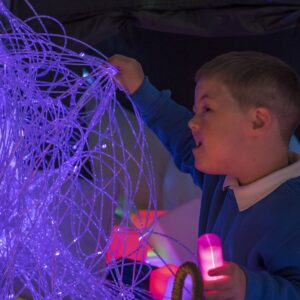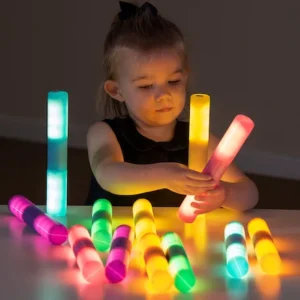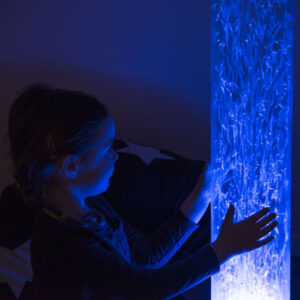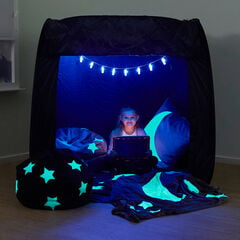In this blog, we explore what a sensory tent is, how to create one, and how they can support children. Mark Chadsgrove, Head of Service at Chadsgrove School Support Services, also explores the different ideas for using a sensory tent that sometimes go beyond the obvious.
What is a sensory tent or dark den?
Many schools and settings struggle to find available spaces for children with sensory processing needs or for those who need some time to regulate and unwind. For a variety of reasons, children sometimes need to be able to ‘escape’ from the overload they can frequently feel, within a busy, working classroom or setting.
This is where a pop-up sensory space or dark den can be useful. For settings that are short of space, a pop-up sensory tent is ideal. It is not only portable and easy to store sensory space, but can be located in different areas according to the changing needs of the children. The pop-up tent/den is available in two colours – black and white, with the larger version being able to accommodate a wheelchair. For settings that have larger spaces and want a more permanent area, larger, more fixed structures are available.
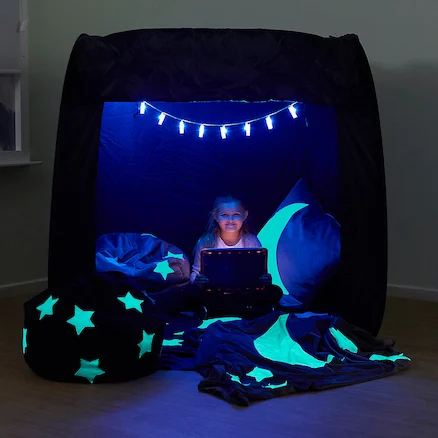
How do I create a sensory space?
When finding a space for the den, consideration should be given to providing somewhere that meets the needs of the child. This may be a space that offers privacy. Alternatively, it could be somewhere for reduced stimulation if needed. The sensory tent is a multi-use and versatile resource. It not only supports sensory needs, but can act as a nurture area. This comfortable space also provides an area where additional learning can go on, such as small phonic or intervention groups. The needs of the children will determine what resources you incorporate into the den. For sensory seekers or those who seek calm, glow resources, bubbles tubes or soft furnishings such as cushions may be suitable. However, some children may want resources that appeal to the different senses or may even prefer an empty space. This is where your knowledge of the children will be invaluable.
Why create a sensory space for children?
The benefits of sensory tents and dark dens extend beyond just creating a quiet space. For children with sensory processing needs, these spaces can also offer:
Regulation of Sensory Input
Sensory tents provide a controlled environment where children can regulate their sensory experiences. It can help them to feel more grounded and focused.
A Sense of Calm
By minimising external stimuli, sensory tents can promote relaxation and a sense of calm. They can also reduce stress and anxiety levels.
Improved Concentration
Children who struggle with sensory overload may find it easier to concentrate and engage with tasks in a sensory tent, leading to improved academic performance.
Self-Regulation Skills
Using sensory tools within the tent such as glow resources and soft furnishings etc, encourages children to develop self-regulation skills, helping them to manage their emotions and behaviours more effectively.
How can I use my sensory tent?
To find out other ways that the tent can be used, we spoke to Mark Chadsgrove, Head of Service at Chadsgrove School Support Services; a specialist advisory teaching and therapy service based in Worcestershire. Here are his thoughts on the sensory tent’s versatility and multi-uses:
In short, the list is absolutely endless: from Going on a Bear Hunt to sight word football, the sensory tent provides a focal point in any room! In addition to using the sensory tent to support regulation, and as a dark space for sensory resources such as lights and bubble tubes, the tent, as our pupils have found out, can have a multitude of different uses and has quickly become a very popular addition to our classrooms!
Ideas for using a sensory tent younger children
At our Alternative Provision, our younger pupils have discovered the sensory tent is great for hide and seek, for retelling stories, and for role play: Going on a bear hunt? Want to catch a big one? Yes of course we do, we’re not scared! Let’s make the tent the bear cave! How wonderful! I can honestly say the tent has provided some truly magical experiences for some of our most vulnerable children and has helped reengage pupils who have been out of education for some time.
Ideas for using a sensory tent with older primary children
Moving on to our older primary children, the tent evolves – can we use it as a goal to support physical needs? Why not we say, but let’s add a challenge! I want you to find all of the words on the beanbags that rhyme with ……..and throw them at the goal. How many can you find? Ready, steady, go!
Another favourite is our word hunt safari. Staff stick words on the inside walls and ceiling of the tent and a pupil has to go in with a torch, find them, read them, and shout them out – how much more fun is that versus boring old flashcards?!
Sensory tent ideas for older children
Onto our older pupils! There is nothing our secondary pupils enjoy more than using the tent to create new spaces. From an area to relax and chill with a book, through to headsets, music, and some sensory lights.
In addition to the fun, we also often see our tent becoming a time where pupils open up and talk. A staff member sat outside the tent, flap closed, with a puppet in hand, its head poking around the tent entrance flap. This can often start quite powerful and meaningful conversations. A safe, quiet space, providing a time to reflect, to talk, to regulate, to understand.
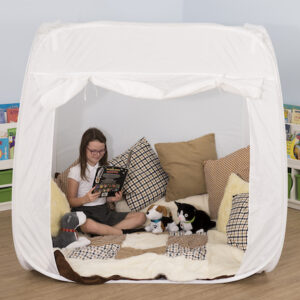
There are so many things you can use a sensory tent for that go beyond the obvious and I enjoy nothing better than rephrasing the conversation that I sadly hear all too often: A sensory tent? That takes up too much space, I can’t have that in here! Let’s change the narrative: A sensory tent? How can you live without one?!
The big question is, how are you going to use yours?
Thanks to Mark Loveday for contributing to this blog.
Mark Loveday is Head of Service at Chadsgrove School Support Services; a specialist advisory teaching and therapy service based in Worcestershire. One of the teams within the Service portfolio is the Pathways Team. This team focus on supporting pupils who are experiencing emotional based school avoidance back into education. The team have 100% success rate of reengaging pupils with learning and back into school full time and have recently won NASEN’s Alternative Provision of the Year award.


